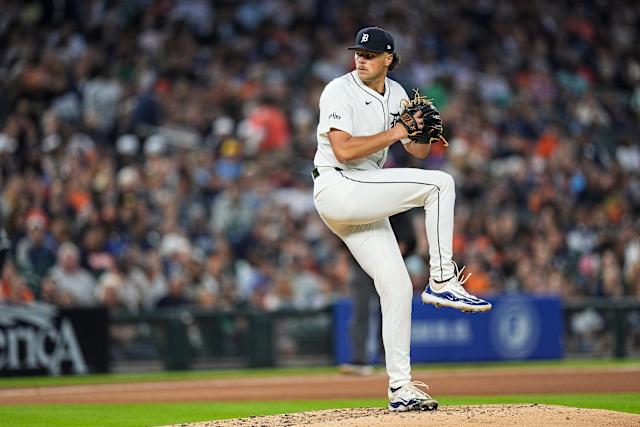Brant Hurter has some data that makes him very effective
Tyler Holton has been quite the surprise for the Tigers since being grabbed off the waiver wire in 2023. He’s given the Tigers 191.1 IP of 2.12 ERA baseball, collecting 29 holds, 9 saves, and even playing the role of the opener by starting 10 games. But the Tigers actually have two Tyler Holtons.
In his brief MLB career, Brant Hurter has repeated what Tyler Holton has done and, in some cases, even better:
|
Tyler Holton |
Brant Hurter |
|
|
K% |
22.1% |
21.1% |
|
BB% |
5.2% |
4.1% |
|
K-BB% |
16.9% |
16.9% |
|
AVG allowed |
0.180 |
0.191 |
|
WHIP |
0.84 |
0.87 |
|
ERA |
2.28 |
2.56 |
|
FIP |
3.35 |
3.28 |
|
xFIP |
3.62 |
3.43 |
Pitch Characteristics
Brant is an interesting pitcher. At 6’6 and 250 lbs, he has an average fastball velocity of just 91.9 MPH and only an average of 6.1 feet of extension, both of which are well below league average and also below league average for LHP. It isn’t normally a combination that we should expect to be successful. Especially when his perceived velocity, which is based off of extension and release point, is 91.2 MPH, yet he has a 2 RV.
A chunk of that is thanks to him being really good at creating a separation between the spin-based movement and observed movement of his sinker. If you’re unfamiliar with what that means, spin-based movement is the movement of the ball based on spin direction and spin rate when the pitcher releases the ball. The observed movement is the actual movement, is measured at the plate, and is the actual movement profile. This is an old, but great write up about these metrics (https://www.mlb.com/news/new-statcast-tool-measures-pitch-spin-direction).
Baseball Savant does a great job at visualizing this using a clock, and if you haven’t seen it before, I would recommend you do so. Brant’s sinker has a spin-based movement that sits at 9:30-10:30 on the the clock, but his observed movement is 8:15 – 9:45. Since he’s getting different movement than the hitters are expecting, the lower velocity is less detrimental. He may not get a ton of whiffs, but 21 of his 26 BIP vs his sinker were groundballs. So when contact is made, it’s not necessarily good contact.
Sweeper
On top of the interesting movement profile, his sweeper has been an insane weapon this year. To dig in, I’d like to look at this plot here:

To summarize: Brant Hurter’s sweeper has one of the highest Whiff% of any pitch by any pitcher thrown at least 70 times. Only a handful have had as high Whiff% and were swung at more, as is seen to the right of the vertical dashed line and to the top of the horizontal dashed line. At the top right of this plot shows that only Gavin Williams has had a more effective sweeper thus far, and it’s not by much. He’s been able to get an increase of 3 inches of drop and 2.5 more inches of glove side movement from last year, both of which are less than league average for the pitch. On top of the great Whiff%, hitters have just a .118/.176 BA and SLG against it, neither of which are that far off from the expected numbers of .182/.215. His RV/100, which is RV/pitches thrown*100, has gone from -0.8 last year to 1.7 so far this year, which is an improvement of 2.5.
Conclusion
I think overall we all know that Brant Hurter has been good. What I did not anticipate seeing was just how good he has been. The funky delivery, the movement profile of his pitches, and the sweeper as a whole have been fun to watch.

